Content
- 1 Choosing bulbs for planting
- 2 Time and timing of planting tulips
- 3 How to plant tulips correctly?
- 4 Tulip care
- 5 Features of care after flowering
- 6 Protection against diseases and pests
- 7 Dates of planting tulips in the ground
- 8 Planting tulips for outdoor cultivation
- 9 Caring for tulips after planting in open ground
- 10 General information on planting
- 11 How and when to plant tulips in spring?
Every amateur florist should know the peculiarities of growing tulips in the open field. These lovely flowers are among the first to delight in spring. But if earlier, in the Soviet years, Dutch tulips lit up with scarlet lights in flower beds, and then "yellow" ones were added to them, today the choice of varieties is unusually large. You can pick flowers of any shade - from white to black, and any shape. Early, middle and late tulips in their flowering will replace each other and delight the owners for a long time with a bright flower bed.

And, of course. flower garden owners want tulips to grow normally, develop and not get sick. What needs to be done for this? So, tulips - planting and care in the open field for these "firstborn of spring".
Choosing bulbs for planting
Bulbs can be either your own, grown on your site, or purchased - of certain varieties. The main thing is that they are healthy. First of all, they are carefully examined.

Bulbs that have begun to rot or are affected by fungal diseases are thrown away.
The rest are sorted by size.
Tulips will grow from large bulbs, which will bloom in spring. Small plants will form, the flowering of which should be expected next season.
Time and timing of planting tulips
Plants are usually planted outdoors in spring or fall. The same is true for tulips.
In autumn
This is the best option for planting plants in central Russia. Tulip bulbs are planted in their designated place from mid-September to mid-October. Of course, the terms can be lengthened if the autumn is warm, and shortened in the event of an unexpected onset of cold weather. The soil temperature should not fall below + 7-10 C, otherwise the root system of the bulbs will not have time to take root, and the flowers will freeze.
But if you follow the rules, planting tulips in the fall will allow you to get strong and healthy flowers next spring.
In the spring
Tulip bulbs can be planted in spring, when the ground has warmed up to the same + 7-10 C. This usually happens in the second half of April or early May. You should not rush to plant so that tulips do not die during frosts.
How to plant tulips correctly?
Tulips are relatively undemanding plants. Therefore, even a novice florist can cope with planting them.
Soil requirements
Tulip bulbs prefer relatively light, slightly alkaline soil. Sandy soil will not work - such soil will have to be enriched with peat or humus, but sandy loam will do just fine.
Heavy clay soils are also not very suitable for tulips - moisture stagnates in them, which can lead to rotting of the bulbs. It is best to add river sand when digging a bed with such soil. As drainage can be used: crushed bark, sawdust, foam crumbs.
It is good to sow the area intended for them with green manure plants a year or two before planting tulip bulbs, and then dig them up along with the soil. This way you can be sure that the necessary nutrients have been introduced into the soil.
Seat selection
The place for tulips should be sunny enough. These plants are demanding for light. In shaded areas, they stretch out, the flowers become small, the petals quickly crumble.

If tulips are to be grown in a flower bed next to tall plants, you should consider this moment and make sure that the tulips are not in the shade.
Tulips grow poorly on slopes - the area should be flat. Stagnation of water in the garden is also contraindicated.
Landing in open ground
Before planting in open ground - prepare the garden. If the soil is acidic, the soil is sprinkled with lime. Humus is introduced a couple of months before planting. But here, too, you cannot overdo it: tulips are plants that are better undernourished than overfed.
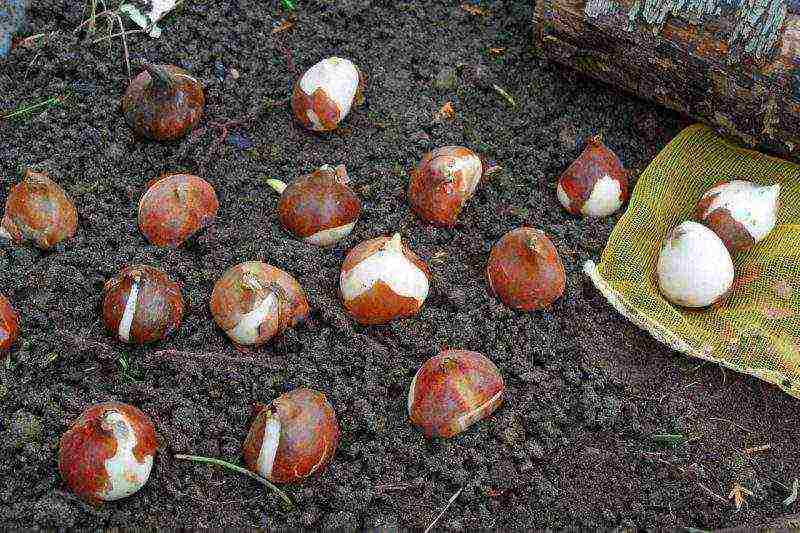
So what are the main rules?
- The bed should be about 15 cm high, at least 1 m wide, the distance between the beds is ideally about 50 cm.
- Furrows are made in the beds, the depth of which reaches the height of 4 bulbs. Furrows are spilled abundantly with water. And the bulbs are kept in a weak solution of potassium permanganate before planting in order to disinfect.
- It is advisable to sprinkle the furrows with river sand; you can use foam crumbs.
- The bulbs are planted at a distance of 6-7 cm from each other.
- Furrows fall asleep.
- The beds are covered with a layer of mulch. You can use compost, sawdust, crushed bark.
If the winters in these places are frosty, tulips - during autumn planting - are additionally covered with a layer of rotten foliage. It must be remembered that it is impossible to use manure that has not yet quail when caring for tulips. The bulbs will suffer from fungal diseases.
Tulip care

After planting in autumn - tulips will no longer require maintenance until spring. You can remember them in March, when the snow begins to melt in the sun. Many growers consider this time to be optimal for the first fertilization. Together with melt water, they will penetrate deep into the soil, and just at the right time - when tulips begin to develop and gain color.
Watering and feeding
Caring for tulips is easy. These plants love water, so they need to be watered regularly and in sufficient quantities. It is undesirable to use a garden hose for this purpose; it is better to take an old watering can. For 1 sq.m. about 20-30 liters of water is introduced. It is recommended to use water that has settled, warmed up to about air temperature.
Today, Nature stores sell a variety of tulip-friendly fertilizers. Among them there are dressings that dissolve in water, or are used dry.
Experienced flower growers feed tulips three times per season.
The first time, as already mentioned, dry fertilizers can be applied directly to the snow. They should include nitrogen, phosphorus, potassium, in a ratio of 2: 2: 1.
The second time the tulips are fed when the buds become visible. Here, the same microelements are used, that is, nitrogen, phosphorus and potassium, only the ratio is different: 1: 2: 2.
The third time fertilization is applied when most of the flowers in the garden begin to shed their petals. Now tulips only need phosphorus and potassium in equal proportions.
It must be remembered that nitrogen is contained in ammonium nitrate, and superphosphate is the best source of phosphorus.
You can also use complex fertilizers, which include manganese and zinc.
Loosening
Slightly loosen the soil in the tulip garden soon after planting. This will help the bulbs take root better.
In the spring, the beds are loosened when the soil begins to dry out. This provides air access to the plant roots.
Features of care after flowering
It may seem that after the end of flowering, tulips are immersed in a deep "hibernation" until the next season. But no, they still need care.
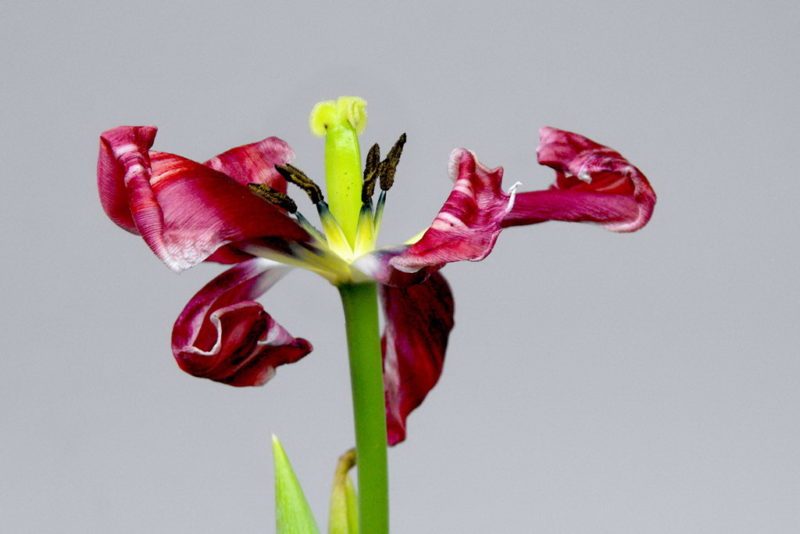
After the tulips have faded, you need to cut off the stems and water the plants well for a couple of weeks. This period also includes the third, final feeding.
Then the yellowed leaves are cut off at the root.
When to dig up tulip bulbs?
This is done around mid-July. In early tulips - you can dig out the bulbs 10-14 days earlier than in later ones. It is important that the day is warm and dry. Dirt is removed from the bulbs, and then they are treated with a weak solution of potassium permanganate and dried.
Storage conditions
Now the florist has to carry out important work, on which it depends - whether his bed with tulips will be good next year.
For storing the bulbs, it is advisable to have boxes in which a net is reinforced instead of the bottom. The bulbs are sorted first by varieties, and then by size - by adults and children, laying them separately - in 1-2 rows.
Each bulb should be carefully inspected to ensure between the healthy ones there was no rotten or affected by the fungus - it will infect the rest. Bulbs that have received mechanical damage, for example, cut by a shovel blow, are also thrown away.
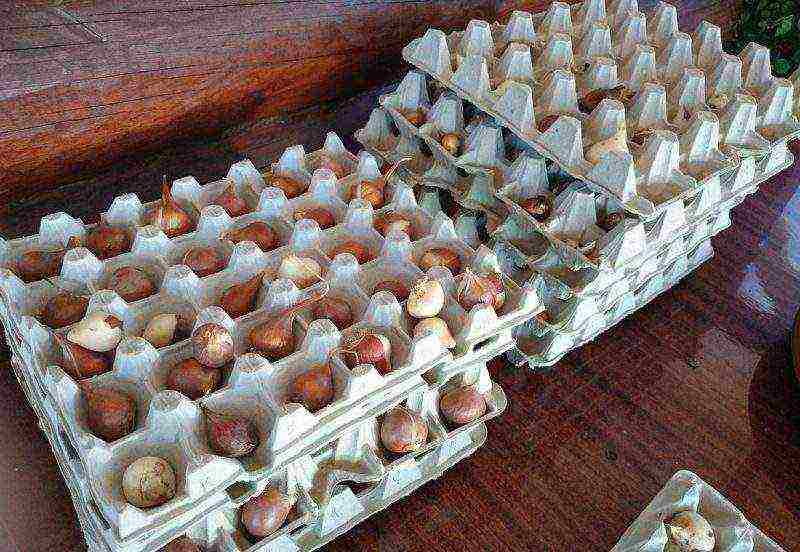
At the end of the process, plates with the names of varieties are fixed in the boxes.
For a couple of weeks, the bulbs are stored at normal summer temperatures in a well-ventilated room. The "crop" should dry well.
In late summer and early autumn, the temperature can be reduced to + 18-20 C. At the same time, the bulbs continue to be periodically examined, immediately removing the diseased.
It is advisable to plant tulips in a new place every autumn, and return to the previous garden bed in 3-4 years.
Protection against diseases and pests
To prevent tulips from getting sick with a number of diseases, you need to provide them with good care. For example, if the drainage is sufficient, the bulbs will not rot in the warm season and will not freeze in the cold.
With proper watering, when no water gets on the leaves, sunburn spots will not appear on them.
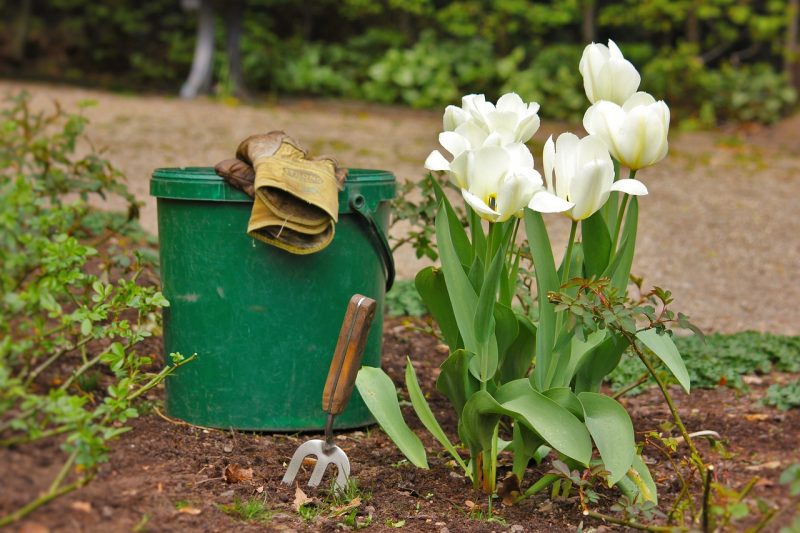
Special preparations will protect tulips from attack by pests such as aphids or slugs. A flower grower should get a sprayer to treat the ground part of the plant. Granules of the "Thunderstorm", which reliably fights slugs, are scattered over the garden. Traps help from the bear.
Among the infectious diseases of tulips, the most common are gray rot and typhulosis. Flowers are treated with drugs such as topsin or foundationol. This should be done before the tulips have blossomed, or after the end of flowering.
Viral diseases are even more dangerous. As a result of them, the so-called "variegation" may appear, as a result of which the variety will be completely lost. Such tulips are dug up and destroyed.
Thus, even a novice florist will be able to successfully plant and grow any varieties of tulips. It is only important to adhere to the basic rules. Growing tulips is a fascinating process that many growers are enthusiastic about.
A flower bed with tulips will be colorful and healthy if the gardener chooses the right place for its organization, prepares purchased or his own bulbs and soil for planting, selects the optimal planting time, provides high-quality care for the planted flowers and the entire flower bed.
The content of the article:
- Preparing purchased bulbs
- Preparing your bulbs
- Soil preparation
- Spring planting tricks
- Tulip planting time
- Flower garden care
- Choosing a site for a flower garden
Few amateur florists do not have at least a couple of tulip varieties in their collection. These flowers are easy to care for and come in a wide variety of shapes and shades, which makes them such a desirable flower bed decoration. Every spring, millions of flower beds bloom across the country, where these wonderful plants are planted.And while it is believed that there is no better time to plant them than early fall, experienced gardeners know a few tricks on how to plant tulips in the spring to make them bloom.
Preparing purchased bulbs
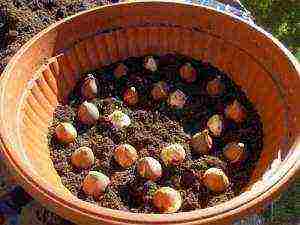
If the bulbs were at your disposal in the fall, then it is better to plant them in the fall. The optimal time for this is September - early October. If the planting material fell into your hands in late autumn or winter, there is no point in planting it in open ground, even if the weather permits.
It is recommended to store the bulbs in a cool dry place until spring, such as in the refrigerator (but not in the freezer). Under the influence of low temperatures, special chemical and physiological processes take place in them, which then contribute to better germination and flowering of plants. Even if you purchased the bulbs just in time for planting, they still need to be kept in the cold for at least 12 hours for them to germinate better.
In late February - early March, after wintering, the planting material must be disinfected in a weakly concentrated manganese solution. In it, the bulbs should be held for half an hour before planting tulips in a pot at home (only in spring they can be transplanted into open ground). The distance between the bulbs can be minimal. From above, they are covered with a five-centimeter layer of earth and so left in a warm (heated) room for about a month until sprouts appear. Only then can tulips be planted outdoors.
If the spring is early and the snow has melted in March, you can try planting the bulbs directly in the open ground. But in this case, be prepared that in the event of more or less severe frosts, the plants may die, and if this does not happen, then the flowers will appear much later in any case than those of those tulips that were planted in the fall.
It should also be noted that if you decide to plant blooming tulips in the spring, then it is better to just transfer the pot to the flower bed and leave it that way. In extreme cases, you can carefully remove them from the pot, trying not to disturb the clod of earth, since otherwise the plant will not be able to take root and die.
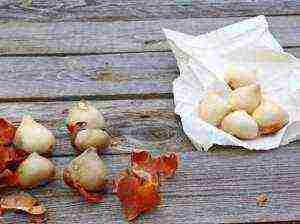
Preparing your bulbs
If you use bulbs obtained from your own flower garden as seed, they should also be pre-planted. Before planting tulips in spring, they must be subjected to the following procedures:
- The bulbs dug out of the flower bed must be peeled from the tough outer skin and the bare bulb must be examined for defects and diseases. In addition, the "naked" bulb is able to more efficiently obtain nutrients from the soil.
- Further, the planting material is degreased and disinfected. To do this, you can use the already mentioned potassium permanganate solution or a special preparation. An alternative to chemistry is celandine solution, in which the bulbs should be kept for about half an hour. This will help kill fungi and bacteria that can damage the bulbs.
- When planting bulbs in pots, it is recommended to use only a clean substrate, since soil taken simply from a flower bed may contain putrefactive bacteria. By the way, it is also recommended to completely replace the topsoil in the flowerbed itself for the same reasons.
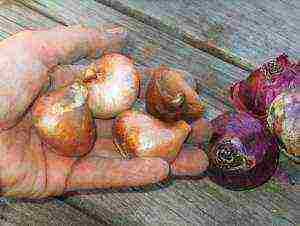
Soil preparation
So, we have already answered the question of whether it is possible to plant tulips in spring. You can, if you know some tricks. But in general, the process of spring planting is not much different from the autumn one. The most important thing in the spring planting of tulips, as well as roses, lilies, or any other flowers, is the correct preparation of the land plot.
The soil in the flower bed must be dug to the depth of the shovel bayonet, that is, by about 25 cm.To increase the permeability of the soil (do not forget that tulip bulbs do not tolerate high humidity), it is recommended to add coarse sand to it.Also, do not forget about fertilizers, in particular about humus (but just do not use fresh manure).
For preventive purposes, the flower garden can be treated with a light fungicidal solution that will kill fungal diseases contained in the soil. If the problem is found already on adult plants, it is recommended to treat it with a solution of twenty grams of working substance per 10 liters of water.
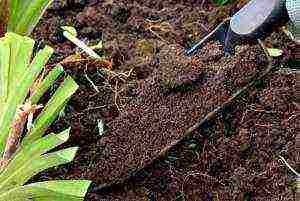
Spring planting tricks
In open ground, adult large bulbs are usually planted one at a time, but last year's "kids" can be placed in groups of five to ten in one hole. Since the stems of tulips rise high enough above the ground to create a continuous carpet of ornamental plants on the flower bed, low-growing flowers (for example, forget-me-nots or daisies) can be planted on them, or ornamental grasses - host, astilba, or bruners.
Planting depth also depends on the size of the bulbs used. Large ones are located at a depth of 10-15 cm, small ones - 7-8 cm.The distance between the planted plants should also be about 8-10 cm.The distance between the rows should be more - 20-25 cm.
When placing the bulbs in the garden, they must be carefully placed in the hole, but in no case pressed into the soil, as this can damage the root system, which at best will slow down the growth of shoots.

Since tulips do not tolerate excess moisture, make sure that the flower bed is sloping. It is unacceptable that there are pits and depressions in the flower garden that can accumulate rainwater.
It is also worth telling another tricky way to plant tulips in the spring in the country. Dutch professional flower growers practice the so-called "floor method" of planting bulbous flowers, which has now been adopted by many domestic gardeners. This method allows you to simultaneously plant several types of flowers with different flowering periods in the same flower bed. Planting technology is extremely simple and involves planting bulbs at different depths. For example, tulip bulbs are first planted, covered with a five-centimeter layer of soil, and then, for example, hyacinths are planted on top. On top of the hyacinths, another layer of earth is placed and, say, crocuses are planted in it. As a result, you get a flower bed, where three types of flowers bloom and fade at once, and you just admire them and do nothing.

Tulip planting time
Now let's take a closer look at the question of when you can plant tulips in the spring so that they give strong shoots that can bloom beautifully. This issue is no less important than the preparation of the flower bed, since the survival of the plants depends on how optimal the planting time was.
As mentioned, tulips are best planted in the fall between early September and mid-October. However, since we are talking about spring planting, then its own rules apply, and there is its own optimal period for planting in open ground.
If the bulbs are planted too early and they germinate before the night frost period ends, the young shoots, and possibly the entire bulb, will die. If you delay planting longer than necessary, the plants will germinate normally and nothing will threaten them, but there is a high risk that they will not bloom this year.

It is believed that tulips can be planted in open ground when the ground at the planting depth warms up to 9-10 degrees Celsius. Depending on the region, this can be from mid-March to early May.
Flower garden care
Since spring planting is not a biological norm for tulips, the issue of high-quality and timely plant nutrition becomes even more urgent. Whether tulips planted in spring will bloom largely depends on this. In order for the shoots to give beautiful flowers, and then form strong viable bulbs, they need to be fed three times:
- For the first time, fertilizers are applied immediately after germination.
- The second feeding is carried out shortly before the beginning of flowering, which will require a lot of energy from the plants.
- The last time tulips are fed immediately after flowering, when the active formation of new bulbs begins.

For feeding, you can use complex fertilizers created specifically for tulips. If this method does not suit you for some reason, you can apply fertilizers separately. In particular, tulips can be fed with nitrogen (ammonium nitrate, ammonium nitrate, etc.), potassium sulfate, phosphorus (superphosphate, calcium phosphate, bone meal).
Choosing a site for a flower garden
In conclusion, it is worth talking a little about where exactly tulips should be planted. These flowers have certain preferences for growing conditions, so providing them with such conditions, you can achieve truly amazing results. In particular, when choosing a landing site, keep in mind that:

- Tulips love light and don't like shade. Make sure there is no shade on the flower bed during the day, neither from trees, nor from buildings or other structures.
- Blooming tulips are afraid of strong winds. To prevent the buds from crumbling ahead of time, protect the flower garden with a barrier of some shrubs or create a low fence from the most windy directions.
- In excessively moist soil, the bulbs rot. If the soil on your site is oversaturated with moisture, raise the flower bed 25-30 cm above the general ground level and create drainage in it by pouring a layer of rubble, broken brick or at least coarse sand under it.
 The blooming of tulips heralds the triumph of spring. If the site is decorated with tulips year after year, planting and caring in the open field is a key moment of such success. Perennial bulbous plants native to Asia have long been the subject of admiration both in their homeland and in the Old World, where they got in the middle of the 16th century.
The blooming of tulips heralds the triumph of spring. If the site is decorated with tulips year after year, planting and caring in the open field is a key moment of such success. Perennial bulbous plants native to Asia have long been the subject of admiration both in their homeland and in the Old World, where they got in the middle of the 16th century.
Thanks to the universal love for these flowers, a hundred years later, Holland began to be called the country of tulips, and today tens of thousands of varieties of these spectacular, but quite affordable plants are distributed around the world.
Dates of planting tulips in the ground
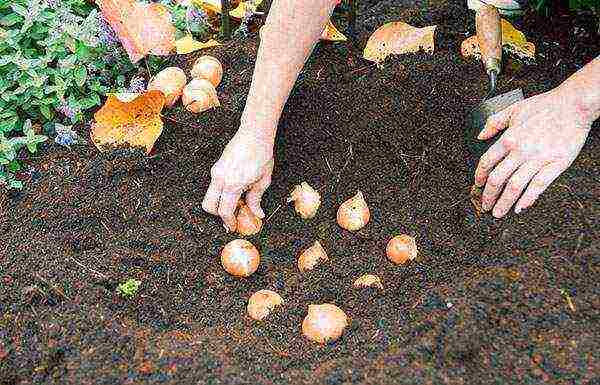 Tulips of cultivars bloom in spring or in the first half of summer. Therefore, the optimal planting time is autumn. In 3-4 weeks, the bulbs acclimatize and form the root system, but do not form the aerial part. This allows the tulips to winter well, and with the arrival of warmth, give strong foliage and open large corollas.
Tulips of cultivars bloom in spring or in the first half of summer. Therefore, the optimal planting time is autumn. In 3-4 weeks, the bulbs acclimatize and form the root system, but do not form the aerial part. This allows the tulips to winter well, and with the arrival of warmth, give strong foliage and open large corollas.
When determining the date of planting tulips, it is important not to be mistaken! If the bulbs enter the soil too early, they can produce foliage. And the coming winter will catch the plants by surprise. The aboveground part will freeze, the underground part will weaken and will not be able to guarantee spring bloom. Late planting threatens that tulips will not have time to take root, severe frosts will kill them or spoil them.
How to choose the optimal time? When to plant tulips in the ground in different regions?
Experienced flower growers advise to pay attention not to the calendar, but to the weather outside the window. The best start for plants is to plant in soil that has cooled to 10-12 ° C.
In the middle lane, such conditions develop by mid-September. To the south, tulips are planted later, to the north, the dates are shifted to the end of August.
If, for some reason, tulips did not hit the flower beds in the fall, you can plant them in the spring. Unfortunately, in this case, the plants have less time to prepare for flowering and accumulate nutrients for the next year. To obtain the desired result and to simplify the care of tulips in the open field, it is better to germinate the bulbs in peat pots filled with a loose nutritious substrate before planting. Before planting, the bulbs are cooled for 24 hours in the vegetable compartment of the refrigerator.
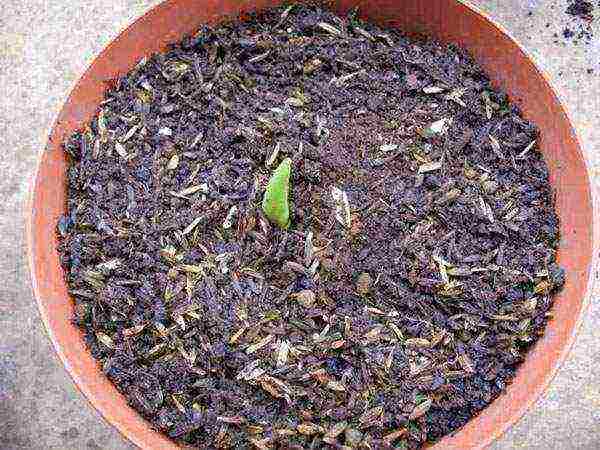 Tulips are transferred to flower beds when it gets warmer and the soil warms up to +15 ° C.This method can be used in all regions, including areas where open field tulips do not survive the winter.
Tulips are transferred to flower beds when it gets warmer and the soil warms up to +15 ° C.This method can be used in all regions, including areas where open field tulips do not survive the winter.
Planting tulips for outdoor cultivation
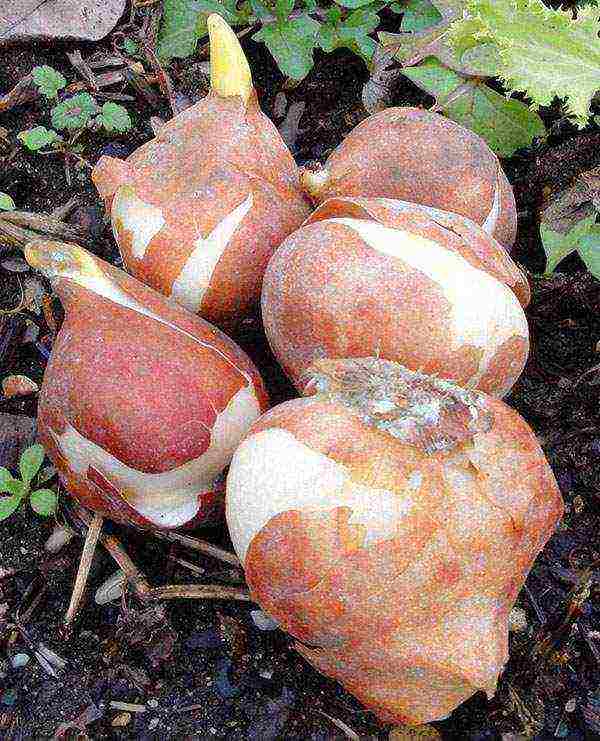 For bright flowering garden tulips require:
For bright flowering garden tulips require:
- sun or transparent partial shade;
- nutritious, necessarily loose soil with a neutral or slightly alkaline reaction;
- wind protection;
- moderate watering.
A site suitable for growing tulips is dug up on a full bayonet, loosened, breaking clods, weeds are selected and nitrogen and potash fertilizers are applied, for example, humus and wood ash. Dense, heavy soil is mixed with sand, peat.
Under tulips, as well as under other bulbous crops, you should not add fresh organic matter, which is often a source of bacterial rot and fungal diseases.
The depth of the open field furrows depends on the size of the bulbs. Therefore, they are pre-sorted, at the same time separating sick and damaged specimens. And healthy ones are immersed in a dense pink solution of potassium permanganate for half an hour and dried thoroughly.
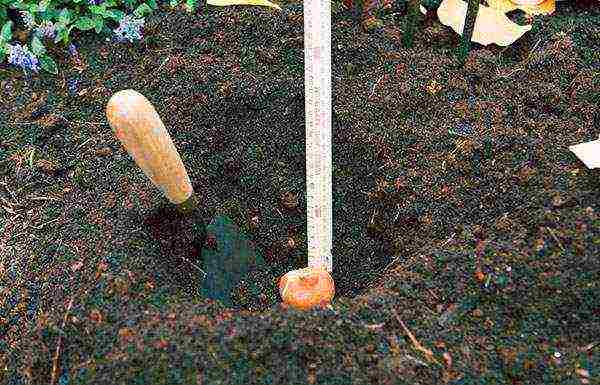 Under adult large bulbs, furrows are made with a depth of 20 to 30 cm, pouring a 10-centimeter drainage cushion of coarse sand on the bottom. The children are planted, slightly pressing, into the holes with the same drainage, but half as small, that is, to a depth of 7-10 cm. When the soil is leveled, the plot is mulched.
Under adult large bulbs, furrows are made with a depth of 20 to 30 cm, pouring a 10-centimeter drainage cushion of coarse sand on the bottom. The children are planted, slightly pressing, into the holes with the same drainage, but half as small, that is, to a depth of 7-10 cm. When the soil is leveled, the plot is mulched.
Caring for tulips after planting in open ground
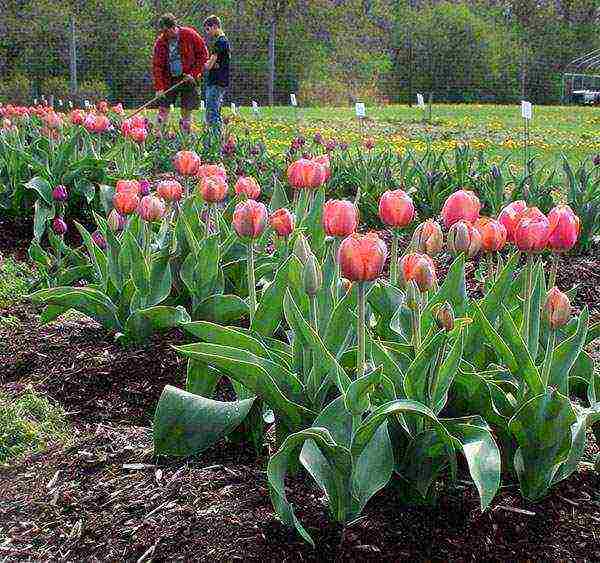 Tulips will respond only to constant and competent care with massive disclosure of bright flowers. Bulbous crops, as a rule, are unpretentious, but still require attention from the appearance of the first leaves until late autumn. Caring for tulips after planting includes:
Tulips will respond only to constant and competent care with massive disclosure of bright flowers. Bulbous crops, as a rule, are unpretentious, but still require attention from the appearance of the first leaves until late autumn. Caring for tulips after planting includes:
- watering, especially plentiful during a set of buds, mass flowering and within 2 weeks after its completion;
- removal of weeds around plantings;
- careful not to damage the root system and bulbs, loosening;
- triple feeding of flowers.
After watering, the soil under the plants should be moist at a depth of 30–40 cm, that is, at least 10–40 liters of water should be consumed per square meter, depending on the type of soil.
Fertilizers in liquid or granular form are part of post-planting tulip care. They are brought in three times:
- In the phase of the appearance of the first shoots, using a mixture of 2 parts of nitrogen, 2 parts of phosphorus salts, 1 part of potassium compounds;
- By the time the green buds appear, feeding the plants with nitrogen, phosphorus and potassium in a ratio of 1: 2: 2;
- After flowering, using potassium-phosphorus formulations, completely abandoning nitrogen.
Speaking of tulip care, we must not forget about a simple but useful procedure. When the flowers wither, they are cut out along with the peduncles. This will prevent the bulbs from wasting the energy that is precious for the growth of the bulbs.
If boxes with seeds are formed and ripen on the stems, there is no need to wait for large bulbs, and the children will not be able to gain significant mass.
Before growing tulips, you need to know that a culture can be in one place for no more than 4 years. Then the risk of accumulation of dangerous bacteria, fungi and soil pests increases, the bulbs naturally age and require replanting. The bulbs remaining in the soil gradually go deeper, so the next year it is more difficult for the sprouts to break through to the surface. As a result, the flowers become smaller, the peduncles become weaker and shorter.
Tulips are dug up when the leaves completely wither and fall off. It is useful to shed the freed area with a solution of phytosporin, potassium permanganate or any available fungicide. Plants that remain in the soil for the winter are thickly mulched with peat, sawdust or covered with spruce branches to avoid freezing.
Video about the correct planting of tulips
 The most suitable time to plant tulips outdoors depends on factors inherent in the local climate and the characteristics of the region.Generally, the best time to transplant or plant tulip bulbs is during the fall. But to the question of how to plant tulips and whether it is possible to plant tulips in the spring in the ground, the answer for all gardeners is ambiguous. Naturally, planting tulips in spring is possible, but these plants will bloom only next year.
The most suitable time to plant tulips outdoors depends on factors inherent in the local climate and the characteristics of the region.Generally, the best time to transplant or plant tulip bulbs is during the fall. But to the question of how to plant tulips and whether it is possible to plant tulips in the spring in the ground, the answer for all gardeners is ambiguous. Naturally, planting tulips in spring is possible, but these plants will bloom only next year.
General information on planting
Planting these plants in the spring on a flower bed or in the soil of flower beds is naturally possible, but this process will only be an intermediate link. The bushes will be able to bloom normally only after a year. For flowering, you need ripe flower bud near the plant bulb. Planting tulips in spring is not so difficult, but it has its own characteristics and nuances.
If the bulbs are planted in the ground without pre-planting, they will begin to bloom two weeks later. For planting in early spring, the bulbs must be placed in a box, which is half filled with good quality soil. With this option, the sprouts on the bulbs will hatch by the time the tulips need to be planted on open ground.
How do you prepare the bulbs for planting in the spring so they bloom?
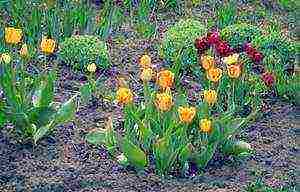 Before planting bulbs in the spring, they certainly need to perform procedures that strengthen their "immunity". To do this, the bulbs, before planting, you need place in a vegetable box at the bottom of the refrigerator, here the temperature readings can be approximately + 4C.
Before planting bulbs in the spring, they certainly need to perform procedures that strengthen their "immunity". To do this, the bulbs, before planting, you need place in a vegetable box at the bottom of the refrigerator, here the temperature readings can be approximately + 4C.
When the hardening of the bulbs is completed, the planting raw materials must be qualitatively protected from possible diseases and pests. For this, the planting material is placed in a slightly pinkish mixture of pharmacy potassium permanganate for half an hour. It must be remembered that the healthiest and strongest tulips can only be grown from quality bulbs.
Before planting bulbs in open field beds in the spring, you need to make an inspection for the integrity of the upper casing layer, as well as the absence of infections with fungal diseases. "Defective" planting raw materials can cause poor flowering and stunted plants.
Also, the pre-planting use of a pharmacy broth of celandine has proven itself excellent, in which you need to soak the tulip bulbs for half an hour, and then dry them a little at room temperature.
How and when to plant tulips in spring?
 The best type of soil for tulips is considered to be humus-enriched, cultivated type of loam and sandy loam with a neutral indicator. A heavy version of clayey soil needs a cardinal improvement method, which consists in the addition of coarse river sand with the introduction of manure and peat... The peat that is used must be neutralized by adding lime.
The best type of soil for tulips is considered to be humus-enriched, cultivated type of loam and sandy loam with a neutral indicator. A heavy version of clayey soil needs a cardinal improvement method, which consists in the addition of coarse river sand with the introduction of manure and peat... The peat that is used must be neutralized by adding lime.
With the onset of spring, and high-quality thawing of the earth, it is necessary to cultivate the soil for replanting or planting tulips. If the ground allows, then its digging must take place to the depth of the shovel bayonet. Then any organic groundbait is added, in addition to fresh manure.
If at the very beginning the fertility of the earth is in doubt, then, in addition to organic fertilizers, various mineral fertilizers must be added. An excellent result is shown by the addition of nitrogen-containing compounds, double superphosphate, and potassium sulfate.
If the land for growing tulips belongs to the "light" class, then the mineral dressing must include small amounts of potassium, phosphorus and nitrogen... If it is necessary to make top dressing in heavy soil, then the basis of the groundbait must be the same elements, but in much larger quantities.
The best temperature regime for high-quality rooting of planting raw materials ranges from + 6C to + 11C. If higher or lower temperatures are observed, then the root system of plants is formed much worse.These indicators make it possible to replant or plant planting raw materials when the earth is already warmed up by at least 11C.
Early flowering plant varieties should be transplanted or planted a few weeks later than late flowering varieties. The planting depth is most often three sizes of the bulb, and the planting density should not exceed more than 2 of its diameters. Planting material, small in size, can be grown separately from the main planting of plants, and then planted in a permanent place in open ground.
Initial care of planted tulips
Care is necessary even at the stage of tulip sprout formation. At this time, care activities consist in the following actions:
-
 Digging up found "defective" plants with their further destruction in order to prevent the spread of infection to healthy tulips.
Digging up found "defective" plants with their further destruction in order to prevent the spread of infection to healthy tulips. - Conducting a thorough examination to identify bulbs that have not sprouted and to determine if tulips are showing signs of disease.
- Carrying out small watering to prevent drying out of the land in flower beds and flower beds.
- Gently loosening the soil near the formed small tulip sprouts to reduce the release of moisture from the ground and increase the availability of the required air to the root system.
- The first dressing of tulips is carried out using nitrogen-containing dressings, which activate the formation of leaves and the rapid growth of the plant. During the care at this stage, it is possible to add the "Crystallin" agent with the addition of tableted microelements or nitroammofosk.
Next top dressing It is not considered necessary for tulip care, but the benefits of adding groundbait to plants at this unfolding of the second and third leaf will be significant.
Caring for tulips after flowering
The period when tulips have completely faded, regardless of the cultivar and variety, the plants planted in spring, needs such events:
- The petals that have fallen from the plant must be removed so that they do not start to rot and do not cause the development of diseases and infections.
- To reproduce the species you like and grow healthy and large bulbs for this purpose, it is necessary to cut off the plant heads a week after flowering. This method activates the growth and formation of the mass of the bulb.
- You can use the test digging option, which makes it possible to determine the level of maturity of tulip bulbs of a particular cultivar or species.
- On faded plants, cutting off the stems must not be done until the period of complete yellowing, since cutting has a negative effect on the ripening of the bulbs.
When digging out the bulbs, you must be very careful not to accidentally injure the roots of the plant. To complete this activity, it is desirable choose a sunny and dry day... This will make it possible to effectively dry all the dug up bulbs.
Diseases and pests
Proper and timely care of plants makes it possible to obtain high-quality tulip bulbs and flowers, but at the same time, one should not forget about the health of tulips. To do this, you need to learn how to recognize diseases, know how to deal with them and, most importantly, be able to prevent these diseases. Preventive measures include such activities:
-
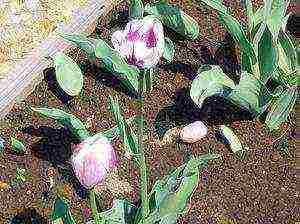 choosing a place where you will plant tulips that meets the requirements of this variety;
choosing a place where you will plant tulips that meets the requirements of this variety; - soil preparation before planting;
- fertilization;
- timely feeding;
- observance of crop rotation - tulips must be grown in one place for no longer than 5 years;
- careful selection and rejection of suspicious and diseased bulbs, planting only healthy planting raw materials;
- compliance with the desired depth and density of planting;
- timely implementation of care measures, maintaining the cleanliness of the tulip collection and good sanitary condition;
- timely harvesting of bulbs;
- damage to the bulbs is unacceptable;
- use of a disinfected container for storing planting material;
- removal of diseased flowers along with the roots.
Naturally, the above measures do not give a complete guarantee that the plants will not get sick, but the implementation of these measures will make it possible to significantly reduce the likelihood of infection tulips diseases.
Tulips, like all plants, are damaged by various diseases and have many pests. In our country, about 35 bacterial, viral and fungal diseases of these plants are known, but most of them are very rare. The greatest harm to plants is brought by diseases such as fusarium, sclerocial and gray rot.
Tulips are not considered the most whimsical flowers. But they still require care. Flower care should begin with the planting of the bulbs. And it doesn't matter when they are planted, in autumn or spring. Much more important create optimal conditions for the development and growth of the bulb. With careful and proper care, tulips bloom in large buds, delighting with their uniqueness and beauty. The main thing is not to forget that varietal tulips do not differ from wild ones.
Rate the article:
(4 votes, average: 2.5 out of 5)


